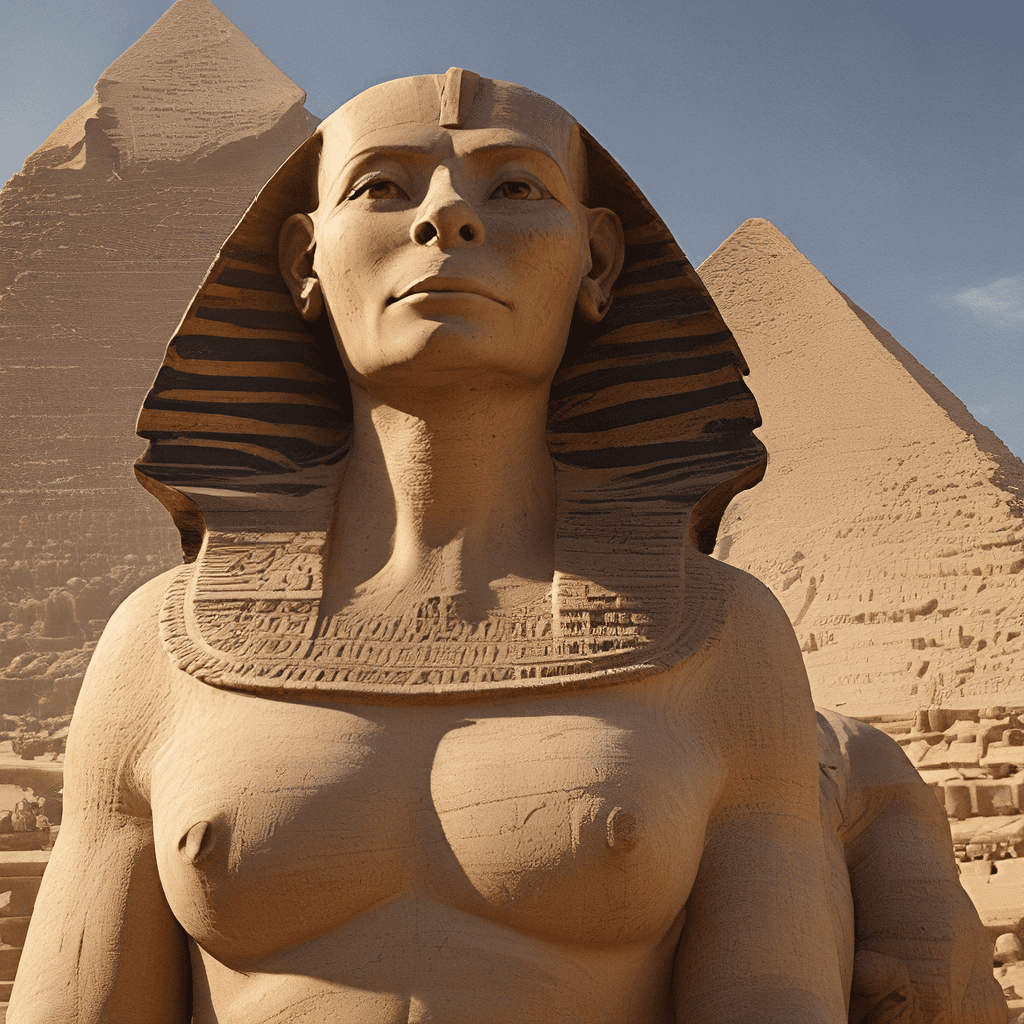The Sphinx: Guardian of Secrets
The Great Sphinx of Giza, a colossal monument carved from limestone, stands as a silent sentinel on the edge of the Sahara Desert. For millennia, this enigmatic figure has captivated the imaginations of people worldwide. The Sphinx, with its lion’s body and human head, is more than just a statue; it is a portal into the depths of ancient Egyptian mythology and a testament to the enduring power of symbolism. Its origins, purpose, and mysteries continue to intrigue scholars and enthusiasts alike, inviting us to delve into the heart of ancient Egyptian civilization.
The Mythological Origins of the Sphinx
In ancient Egyptian mythology, the Sphinx, known as “She who knows,” was an enigmatic being associated with wisdom, power, and the guardianship of sacred knowledge. The Sphinx’s origins trace back to the ancient Egyptian god Horus, who embodied royal power and protection. The lion, a majestic creature that roamed the deserts of Egypt, was considered a fierce protector and a symbol of royalty. The combination of the lion and the human head, forming the Sphinx, represented the union of strength and intellect, a testament to the power of knowledge and the guardianship of secrets.
The Sphinx in Egyptian Mythology: A Hybrid of Power
The Sphinx’s unique form, a hybrid of the fierce lion and the wise human, reflects the ancient Egyptian belief in the interconnectedness of different forces. It embodies the duality of nature, the balance of power and wisdom, and the ability to protect and guide. The lion symbolizes strength, courage, and the power of the sun god Ra, while the human head represents the intellectual and spiritual aspects of humanity. The Sphinx’s enigmatic nature, its ability to both terrify and inspire, is an embodiment of the complex and multifaceted nature of the ancient Egyptian world.
The Sphinx and the Sun God Ra
The Sphinx’s connection with the sun god Ra is a prominent feature in Egyptian mythology. Ra, the god of the sun, was considered the source of life and creation. The Sphinx, as a guardian of the sun god, was believed to possess great power and wisdom, and it was often depicted as a protector of the Pharaoh’s tomb. The Sphinx’s association with Ra reinforces its power and significance as a symbol of royal authority and divine protection.
The Sphinx as a Symbol of Royal Power
The Sphinx’s association with royal power is evident in its depiction as a guardian of the Pharaoh’s tomb. The Sphinx represented the Pharaoh’s strength, wisdom, and divine connection, and it functioned as a powerful symbol of the Pharaoh’s authority. The Sphinx’s purpose was to protect the Pharaoh’s eternal resting place, symbolizing the Pharaoh’s enduring legacy and connection to the divine realm. This association with royal power solidified the Sphinx’s position as a revered symbol of ancient Egyptian civilization.
The Great Sphinx of Giza: A Monumental Enigma
The Great Sphinx of Giza, one of the most iconic monuments in the world, stands as a testament to the artistry and engineering prowess of ancient Egypt. Carved from a single piece of limestone, this colossal figure has captivated the imaginations of people for centuries. The Sphinx, with its weathered features and majestic stance, has inspired countless tales and theories about its origins, purpose, and mysteries. While some believe it represents a particular Pharaoh, others speculate about its connection to ancient rituals and esoteric knowledge. The enigmatic nature of the Sphinx continues to invite speculation and wonder, making it a timeless symbol of the unknown.
Exploring the Sphinx’s Construction: A Testament to Ancient Engineering
The construction of the Great Sphinx of Giza is a testament to the skill and ingenuity of ancient Egyptian architects and engineers. Carving a monument of such immense size and detail from solid rock required a combination of advanced technology and precise planning. The Sphinx’s construction is a testament to the Egyptians’ mastery of stonework, their understanding of geometry and engineering, and their ability to mobilize large-scale labor forces to achieve grand architectural feats. The sheer scale and complexity of the Sphinx’s design have inspired awe and wonder for centuries, a lasting tribute to the ingenuity of ancient Egypt.
Theories and Interpretations: Unraveling the Sphinx’s Purpose
The Great Sphinx’s true purpose remains a subject of debate and speculation. Some scholars believe it was a guardian of the Pharaoh’s tomb, protecting the royal burial chamber from intruders. Others suggest it represented the Pharaoh’s power and connection to the divine, serving as a powerful symbol of the Pharaoh’s authority. Still, others speculate about its connection to ancient rituals and esoteric knowledge, with some even theorizing about its role in the transmission of ancient wisdom. The Sphinx’s enigmatic nature, its lack of inscription or definitive historical information, has fueled countless theories and interpretations, making it a timeless symbol of the mysteries of the past.
The Sphinx and the Mysteries of the Pyramids
The Great Sphinx of Giza stands in close proximity to the majestic pyramids of Giza, adding to its aura of mystery. The Sphinx, like the pyramids, is an enduring symbol of ancient Egyptian civilization, embodying the power and grandeur of a lost civilization. The pyramids and the Sphinx are interconnected in their symbolism and purpose, both representing the Pharaoh’s power, the pursuit of immortality, and the mysteries of the afterlife. Their proximity to each other suggests a connection, a shared purpose, and an enduring legacy that continues to captivate the imagination.
The Enduring Legacy of the Sphinx: A Symbol of Time and Eternity
The Sphinx, despite the erosion of time and the mysteries that surround its origins, remains a powerful symbol of ancient Egyptian civilization, a testament to the enduring power of art, mythology, and symbolism. The Sphinx has inspired countless stories, poems, and works of art, and it continues to captivate the imaginations of people worldwide. Its enduring legacy is a testament to the power of human creativity and the enduring mystery of the past.




